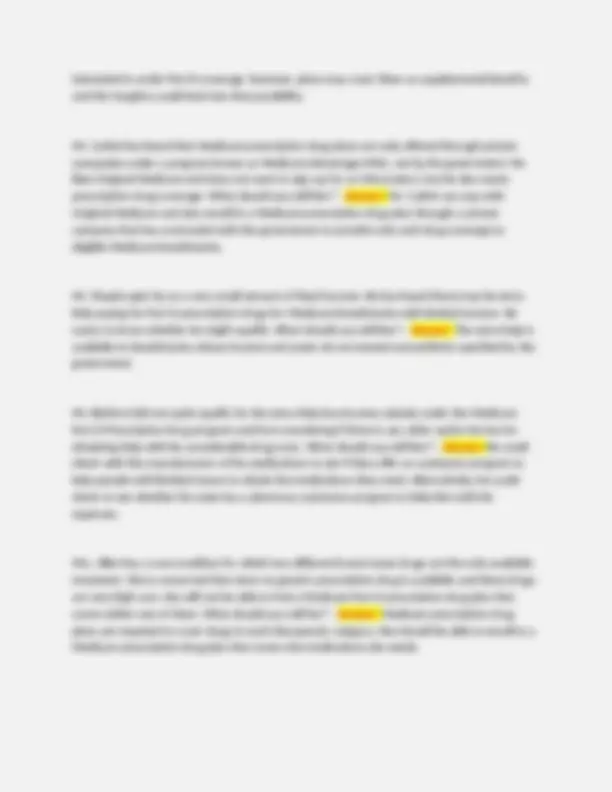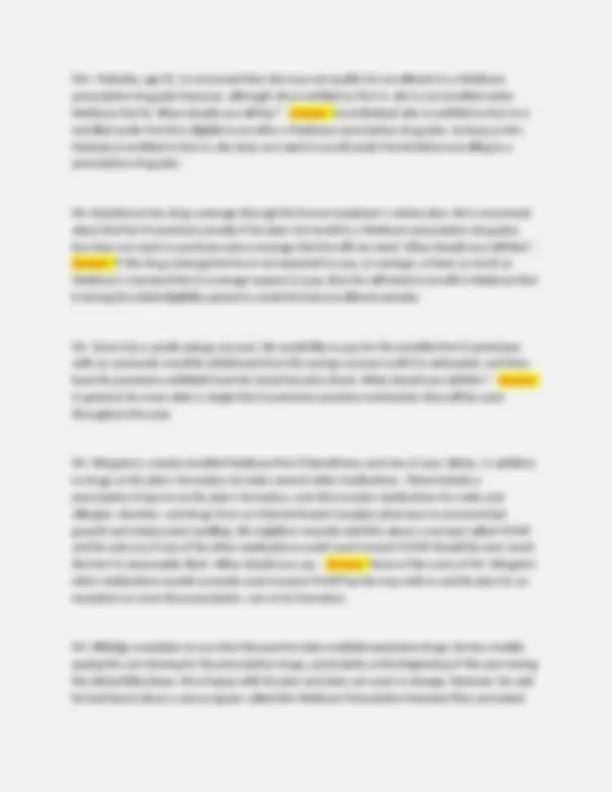





Study with the several resources on Docsity

Earn points by helping other students or get them with a premium plan


Prepare for your exams
Study with the several resources on Docsity

Earn points to download
Earn points by helping other students or get them with a premium plan
Community
Ask the community for help and clear up your study doubts
Discover the best universities in your country according to Docsity users
Free resources
Download our free guides on studying techniques, anxiety management strategies, and thesis advice from Docsity tutors
This study guide provides a comprehensive overview of medicare part d prescription drug plans, addressing common scenarios and questions beneficiaries may encounter. it covers topics such as formulary exceptions, plan selection, cost-sharing, and available assistance programs. The guide offers practical advice and explanations of key concepts, making it a valuable resource for understanding and navigating the complexities of medicare part d. it is particularly useful for those seeking to understand their options and make informed decisions about their prescription drug coverage. The guide uses real-life examples to illustrate key points and provides clear answers to frequently asked questions.
Typology: Exams
1 / 5

This page cannot be seen from the preview
Don't miss anything!




Mr. Zachow has a condition for which three drugs are available. He has tried two but had an allergic reaction to them. Only the third drug works for him and it is not on his Part D plan's formulary. What could you tell him to do? - Answer: Mr. Zachow has a right to request a formulary exception to obtain coverage for his Part D drug. He or his physician could obtain the standardized request form on the plan's website, fill it out, and submit it to his plan. Mr. Rice is 68, actively working, and has coverage for medical services and medications through his employer's group health plan. He is entitled to premium free Part A and thinking of enrolling in Part B and switching to an MA-PD because he is paying a very large part of his group coverage premium, and it does not provide coverage for a number of his medications. Which of the following is NOT a consideration when making the change? - Answer: Mr. Rice's retiree plan is required to take him back if, within 63 days of having voluntarily quit the employer's plan, he decides that he prefers it to his Medicare Part D plan. Mrs. Hernandez is one of your clients. She has read that there is a new program that may help her manage prescription drug costs. What do you tell her about the Medicare Prescription Payment Plan? - Answer: Part D enrollees can opt into the Medicare Prescription Payment Plan at the beginning of the plan year or any point during the year. Mrs. Lopez is enrolled in a cost plan for her Medicare benefits. She has recently lost creditable coverage previously available through her husband's employer. She is interested in enrolling in a Medicare Part D prescription drug plan (PDP). What should you tell her? - Answer: If a Part D benefit is offered through her plan she may choose to enroll in that plan or a standalone PDP. One of your clients, Lauren Nichols, has heard about a Medicare concept from one of her neighbors called TrOOP. She asks you to explain it. What do you say? - Answer: TrOOP stands for
true out-of-pocket costs that count toward the Medicare Part D catastrophic limit and include not only expenses paid by a beneficiary but also in some instances amounts paid by or through qualified State Pharmaceutical Assistance Programs. Ms. Edwards is enrolled in a Medicare Advantage plan that includes prescription drug plan (PDP) coverage. She is traveling and wishes to fill two of the prescriptions that she has lost. How would you advise her? - Answer: She may fill prescriptions for covered drugs at non-network pharmacies, but likely at a higher cost than paid at an in-network pharmacy. Mrs. Roswell is a new Medicare beneficiary who has just retired from retail work. She is interested in selecting a Medicare Part D prescription drug plan. She takes several medications and is concerned that she has not been able to identify a plan that covers all of her medications. She does not want to make an abrupt change to new drugs that would be covered and asks what she should do. What should you tell her? - Answer: Every Part D drug plan is required to cover a single one-month fill of her existing medications sometime during a 90-day transition period. Mr. Jacob understands that there is a standard Medicare Part D prescription drug benefit, but when he looks at information on various plans available in his area, he sees a wide range in what they charge for deductibles, premiums, and cost sharing. How can you explain this to him?
Mrs. Mulcahy, age 65, is concerned that she may not qualify for enrollment in a Medicare prescription drug plan because, although she is entitled to Part A, she is not enrolled under Medicare Part B. What should you tell her? - Answer: An individual who is entitled to Part A or enrolled under Part B is eligible to enroll in a Medicare prescription drug plan. As long as Mrs. Mulcahy is entitled to Part A, she does not need to enroll under Part B before enrolling in a prescription drug plan. Mr. Hutchinson has drug coverage through his former employer's retiree plan. He is concerned about the Part D premium penalty if he does not enroll in a Medicare prescription drug plan, but does not want to purchase extra coverage that he will not need. What should you tell him? - Answer: If the drug coverage he has is not expected to pay, on average, at least as much as Medicare's standard Part D coverage expects to pay, then he will need to enroll in Medicare Part D during his initial eligibility period to avoid the late enrollment penalty. Mr. Torres has a small savings account. He would like to pay for his monthly Part D premiums with an automatic monthly withdrawal from his savings account until it is exhausted, and then have his premiums withheld from his Social Security check. What should you tell him? - Answer: In general, he must select a single Part D premium payment mechanism that will be used throughout the year. Mr. Wingate is a newly enrolled Medicare Part D beneficiary and one of your clients. In addition to drugs on his plan's formulary, he takes several other medications. These include a prescription drug not on his plan's formulary, over-the-counter medications for colds and allergies, vitamins, and drugs from an Internet-based Canadian pharmacy to promote hair growth and reduce joint swelling. His neighbor recently told him about a concept called TrOOP and he asks you if any of his other medications could count toward TrOOP should he ever reach the Part D catastrophic limit. What should you say. - Answer: None of the costs of Mr. Wingate's other medications would currently count toward TrOOP but he may wish to ask his plan for an exception to cover the prescription, not on its formulary. Mr. Hildalgo complains to you that because he takes multiple expensive drugs, he has trouble paying his cost sharing for his prescription drugs, particularly at the beginning of the year during the deductible phase. He is happy with his plan and does not want to change. However, he said he had heard about a new program called the Medicare Prescription Payment Plan and asked
whether it might help. What do you tell him? - Answer: The Medicare Prescription Payment Plan helps spread out beneficiary cost-sharing payments but does not decrease the total amount owed. Who is most likely to benefit from the Medicare Prescription Payment Plan? - Answer: Kevin, who suffered a heart attack at the beginning of the year requiring him to take an expensive brand name blood thinner on a daily, as well as an equally expensive injectable cholesterol medication on a bi-weekly basis for which he incurs high out-of-pocket costs.